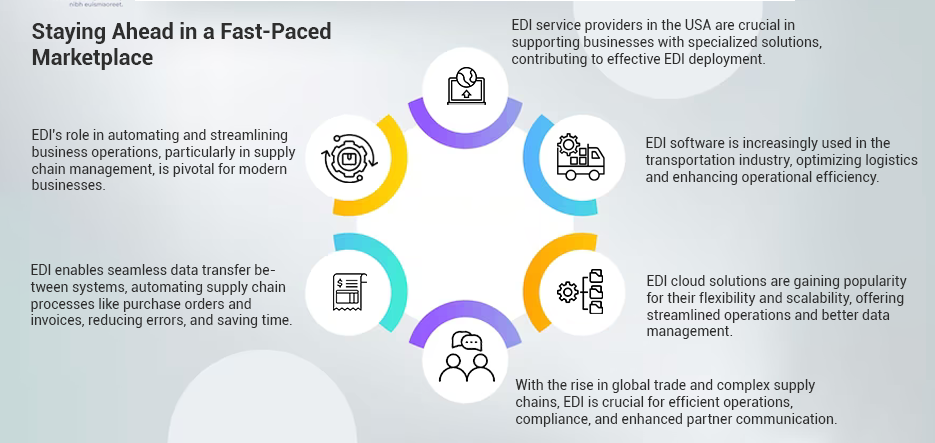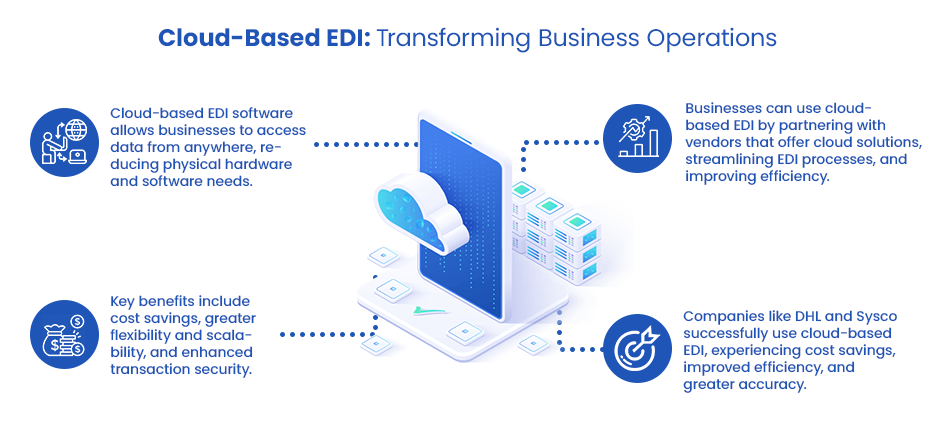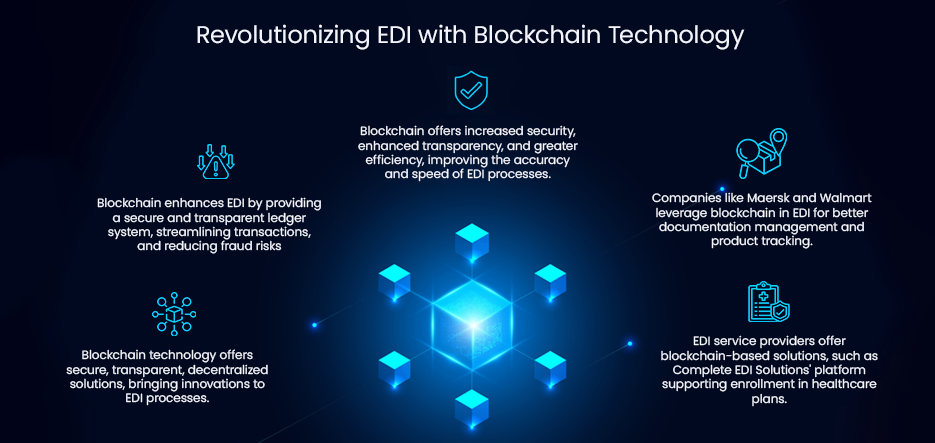Table of Contents
The importance of efficient communication and streamlined operations cannot be overstated in today’s fast-paced business environment. As a result, many companies have turned to EDI solutions to help manage their supply chains, reduce errors, and increase productivity. As we look to the future, staying up-to-date with EDI’s latest trends and technologies is essential to remain competitive in the marketplace.
Also read : Managed EDI Updates for 2025
EDI is the computer-to-computer exchange of business documents between companies. It allows for seamless data transfer between systems, eliminating the need for manual entry and reducing the likelihood of errors. With EDI, businesses can automate many supply chain processes, such as purchase orders, invoices, and shipping notices, saving time and resources.
The importance of EDI in modern business operations cannot be overstated. With the increase in global trade and the complexity of supply chain operations, EDI has become a critical component of business success. Companies that utilize EDI can benefit from increased efficiency, reduced errors, and improved communication with trading partners. EDI can also help businesses comply with industry regulations and customer requirements.
This blog post explores EDI’s future and the latest trends and technologies that will shape its evolution. Specifically, we will focus on the growing popularity of EDI cloud solutions, the use of electronic data interchange software in the industries, and the role of EDI service providers in the USA. By examining these trends, we can better understand how businesses can adapt their EDI strategies to stay ahead of the curve and maximize their competitive advantage.

Current State of EDI
Electronic Data Interchange (EDI) has been integral to business operations for several decades. It is a technology that enables the exchange of business documents in a standardized electronic format.
Explanation of How EDI is Currently Being Used in Business Operations
EDI is widely used in retail, healthcare, logistics, and manufacturing industries. The retail industry uses EDI for purchase orders, invoices, and shipping notifications. EDI in healthcare is used for claims processing, patient eligibility verification, and prescription processing. In logistics, EDI is used for transportation and warehouse management, while in manufacturing, it is used for procurement, inventory management, and production scheduling.
EDI has become a standard business communication method, allowing companies to exchange information with their trading partners more efficiently and accurately. It enables businesses to automate processes, reduce errors, and improve productivity. With the growth of e-commerce and the increasing globalization of business, the demand for EDI has increased.
Discussion of the Benefits and Challenges of Using EDI
The benefits of using EDI are significant. It helps businesses to reduce manual processing, minimize errors, and increase efficiency. EDI also enables businesses to reduce costs associated with paper-based transactions such as printing, postage, and storage. It also improves supply chain visibility and enables businesses to respond quickly to changing market conditions.
However, there are also challenges associated with the implementation of EDI. One of the main challenges is the initial cost of implementing EDI software and the associated hardware. Another challenge is the complexity of EDI standards and the need for ongoing maintenance and updates. Furthermore, businesses must comply with various EDI regulations and standards.
Looking to the Future of EDI
As the business landscape continues to evolve, the future of EDI is promising. EDI Cloud solutions are on the rise, providing businesses greater flexibility and scalability. Additionally, the use of AI and machine learning in EDI is increasing, enabling businesses to improve their processes and reduce errors. In the US, many EDI service providers offer comprehensive solutions to businesses of all sizes.
In addition, using the EDI VAN (Value Added Network) for EDI communication is becoming less popular, with more businesses opting for direct connections or web-based communication. It allows for greater control and security in the exchange of business documents.
Transform Your Workflow With Our EDI Services
Market Trends for 2025 and Beyond
Businesses should be aware of several market trends for EDI as we move into 2025 and beyond. These trends are expected to impact the future of EDI significantly and will require businesses to adapt their strategies to stay competitive.
Overview of the latest market trends for EDI
One of EDI’s most significant market trends is the rise of cloud-based solutions. More and more businesses are moving their EDI operations to the cloud, allowing for greater scalability, flexibility, and cost savings. With the increasing availability of EDI cloud software and support services, businesses can streamline their EDI processes and reduce the complexity of their operations.
Another market trend for EDI is the increasing use of artificial intelligence (AI) and machine learning. These technologies are being integrated into EDI software vendors’ solutions to improve the accuracy and efficiency of data exchange. It allows businesses to automate more of their EDI processes and reduce the risk of errors or delays.
Finally, blockchain technology is also emerging as a potential game-changer for EDI. By providing a secure and transparent way to record transactions, blockchain could significantly reduce the risk of fraud or errors in EDI operations. Several companies are already exploring the use of blockchain in their EDI processes, and this trend is expected to continue to grow in the coming years.
Explanation of how these trends will impact the future of EDI
The increasing adoption of EDI cloud-based solutions, AI, and blockchain in EDI is expected to significantly change how businesses operate. With cloud-based solutions, businesses can streamline their EDI processes, reduce costs, and increase scalability. It will allow businesses to be more agile and responsive to changing market conditions.
Integrating AI and machine learning in EDI will also significantly impact EDI support services. By automating more of their EDI processes, businesses will be able to reduce the risk of errors and delays while also increasing the speed and accuracy of data exchange. It will enable businesses to operate more efficiently, reduce costs, and improve customer satisfaction.
Using blockchain technology in EDI will provide a secure and transparent way to record transactions, and blockchain could significantly reduce the risk of fraud or errors in EDI operations. It could increase trust between trading partners, reduce disputes, and improve the overall efficiency of EDI processes.
Discussion of how businesses can adapt to these trends
Businesses must invest in EDI cloud-based solutions, AI and machine learning, and blockchain technology. It will require businesses to work closely with their EDI software vendors to identify the best solutions for their needs.
Additionally, businesses must train their employees to use these new technologies effectively. It will require a significant investment in training and development, but it will be necessary to ensure that businesses can fully realize the benefits of these new technologies.
Also Read: The Importance of EDI Training and Support
Cloud-Based EDI

Cloud-based EDI software allows businesses to access their data from anywhere with an internet connection, reducing the need for on-premise hardware and software. Here are some benefits of using cloud-based EDI and some examples of companies successfully using these solutions.
Benefits of using cloud-based EDI
One of the main benefits of using cloud-based EDI is the reduced need for on-premise hardware and software. It can save businesses money because they do not need to purchase and maintain their hardware and software. Additionally, cloud-based EDI software can be accessed from anywhere with an internet connection, allowing greater flexibility and scalability. Cloud-based solutions can also provide greater security for EDI transactions, as cloud vendors are typically more equipped to handle security threats and provide more robust security features.
How businesses can take advantage of cloud-based EDI solutions
Businesses can use cloud-based EDI solutions by partnering with EDI software vendors that offer cloud-based options. These vendors typically offer support services and resources to help businesses transition to EDI cloud-based solutions. In addition, businesses can leverage cloud-based solutions to streamline their EDI processes and improve efficiency. For example, cloud-based solutions can allow for faster onboarding of trading partners, as the process can be completed entirely online.
Examples of companies that are successfully using cloud-based EDI
Many companies are already successfully using cloud-based EDI solutions.
- For example, the global logistics company DHL uses a cloud-based EDI system to manage their supply chain operations. DHL can streamline their processes and improve efficiency by using a cloud-based solution.
- Another example is the food distributor Sysco, which uses a cloud-based EDI system to manage its supply chain and automate its invoicing process. Since implementing its cloud-based solution, Sysco has reported significant cost savings and improved accuracy.
AI and Machine Learning in EDI
In recent years, artificial intelligence (AI) and machine learning have emerged as powerful tools for businesses to streamline operations and improve efficiency. EDI solution providers have quickly recognized these technologies’ potential and are now integrating them into their software solutions. This section will explore how AI and machine learning are used in EDI and how businesses can leverage these technologies to improve their EDI processes.
Use of AI and machine learning in EDI
AI and machine learning are used in various ways in EDI, from automating routine tasks to predicting and preventing errors. For example, machine learning algorithms can analyze large data sets to identify patterns and anomalies, enabling businesses to optimize their supply chain operations and reduce costs. AI-powered chatbots can also automate customer service interactions, providing faster and more personalized customer support.
How businesses can leverage AI and machine learning to improve their EDI processes
Businesses can leverage AI and machine learning to improve their EDI processes in several ways. For example, they can use machine learning algorithms to analyze EDI transactions and predict potential errors or delays, allowing them to address these issues before they occur proactively. AI-powered chatbots can also automate routine EDI tasks, such as order processing and invoice validation, freeing up staff to focus on more complex tasks.
Another way that businesses can leverage AI and machine learning is through the use of predictive analytics. By analyzing historical EDI data, businesses can identify trends and patterns that can help them optimize their supply chain operations and improve forecasting accuracy. It can help them reduce costs and improve efficiency, particularly for small businesses with limited resources.
Examples of companies that are using AI and machine learning in their EDI operations
Several companies already use AI and machine learning in their EDI operations to improve efficiency and reduce costs.
- For example, Walmart is using machine learning to optimize its supply chain operations, enabling it to reduce stockouts and improve inventory management. The company also uses AI-powered chatbots to automate routine EDI tasks like invoice validation and order processing.
- Another example is Anthem, which uses machine learning to analyze EDI transactions and predict potential errors or delays. The company also uses AI-powered chatbots to automate customer service interactions, providing faster and more personalized customer support. These examples highlight how AI and machine learning can be used to improve EDI processes and drive business success.
Blockchain in EDI

In recent years, blockchain technology has been making waves across various industries due to its ability to provide secure, transparent, and decentralized transactions. The EDI industry is no exception to this trend, and blockchain is being increasingly explored as a potential solution to enhance the existing EDI processes.
How blockchain technology is being used in EDI
Blockchain technology provides a distributed ledger system that enables secure and transparent transactions between parties without intermediaries. In EDI, blockchain can enhance the security and transparency of transactions, thereby reducing the risk of fraud and errors. Using blockchain can also help streamline the EDI process, making it faster and more efficient.
Potential benefits of using blockchain in EDI
One of the primary benefits of using blockchain in EDI is increased security. With blockchain, transactions are stored in a tamper-proof distributed ledger, reducing the risk of fraud or data tampering. Blockchain can also increase transparency, enabling all parties to access the same data in real-time. It can help to reduce errors and improve the accuracy of transactions.
Another benefit of using blockchain in EDI is increased efficiency. Blockchain transactions can be executed faster than traditional EDI processes, and smart contracts can automate many of the manual processes involved in EDI transactions. It can reduce costs and improve the overall speed and efficiency of the EDI process.
Examples of companies that are exploring the use of blockchain
Several companies are already exploring the use of blockchain in their EDI processes.
- One such company is Maersk, a global shipping company that has partnered with IBM to develop a blockchain-based platform for managing shipping documentation.
- Another company, Walmart, uses blockchain to track the origin of its food products and ensure their safety and quality.
Challenges and Opportunities for EDI
While EDI offers numerous benefits to businesses, there are also challenges that organizations may face when implementing EDI. This section will discuss some challenges and opportunities businesses may encounter when using EDI.
Discussion of the challenges that businesses may face when implementing EDI
One of the biggest challenges businesses may face when implementing EDI is ensuring compatibility with various file formats. For instance, in the healthcare industry, the 834 file format transfers data related to employee benefits enrollment. Companies must ensure their EDI systems can process and read these file formats correctly.
Another challenge is finding the right EDI integration software. There are various EDI software providers, and choosing the right one can be daunting. Companies should ensure that the software they choose offers the features and capabilities they require for their business needs.
Finally, there is the challenge of change management. EDI implementation may require significant changes to a company’s existing business processes. It can cause disruptions, and employees may need the training to adapt to the new system.
Explanation of how businesses can overcome these challenges
To overcome the compatibility challenge, companies should ensure that their EDI systems support various file formats, including the 834 file format. It can be achieved by working with an EDI software provider with the necessary features and capabilities.
Companies should conduct thorough research and compare different software solutions to address the challenge of choosing the right EDI integration software. They should consider the software’s cost, ease of use, scalability, and compatibility with existing systems.
Companies should communicate with and involve their employees in the EDI implementation process to manage change effectively. Training and support can also help employees adapt to the new system.
Discussion of the opportunities that EDI presents for businesses
Despite the challenges, EDI presents numerous opportunities for businesses. For instance:
- EDI can help companies streamline business processes, reduce costs, and improve efficiency.
- EDI can also help businesses improve customer service by providing faster order processing and visibility of supply chains.
In the healthcare industry, EDI can help providers and insurers improve the accuracy and speed of claims processing, resulting in cost savings and improved patient outcomes.
Furthermore, EDI can help businesses improve their data management and analysis capabilities. EDI systems can provide real-time data that businesses can use to make informed decisions, optimize their supply chains, and improve their overall business performance.
While implementing EDI can present challenges, businesses can overcome these challenges and take advantage of the opportunities EDI presents. By embracing EDI, businesses can streamline operations, reduce costs, and improve customer service and overall performance.
Embrace The Future With Our Innovative and Advanced EDI Solutions
Conclusion
In conclusion, the future of EDI looks bright as we head into 2025 and beyond. With the latest market trends, businesses can benefit significantly from embracing cloud-based EDI solutions, incorporating AI and machine learning in their EDI processes, and exploring the potential of blockchain in EDI. EDI solution providers in the USA are also making it easier for businesses of all sizes to implement and optimize their EDI operations.
As we move towards a more connected world, it’s clear that EDI will play an increasingly vital role in business operations. The ability to seamlessly exchange data electronically is essential in today’s fast-paced business environment, and the benefits of EDI are precise – from improving supply chain efficiency to reducing errors and costs.
The rise of EDI cloud solutions and the increasing use of AI and machine learning in EDI processes will enable businesses to streamline their operations, reduce manual processes, and optimize their supply chain management. Additionally, blockchain technology has the potential to revolutionize EDI, providing increased security and transparency in data exchange.
However, implementing EDI has its challenges. Businesses must be willing to invest in the right electronic data interchange software, ensure data accuracy, and collaborate with their trading partners effectively. EDI service providers in the USA can help businesses overcome these challenges and optimize their EDI operations.
As the future of EDI continues to evolve, businesses must stay ahead of the curve to remain competitive. The future of EDI is bright, and with the right tools and strategies in place, businesses can succeed in this rapidly evolving landscape.
Frequently Asked Questions (FAQs)






